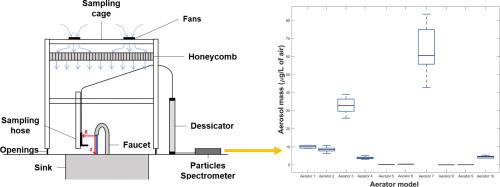Science of the Total Environment ( IF 8.2 ) Pub Date : 2021-02-06 , DOI: 10.1016/j.scitotenv.2021.145690 Marie-Ève Benoit , Michèle Prévost , Antonella Succar , Dominique Charron , Eric Déziel , Etienne Robert , Emilie Bédard

|
Faucet aerators have been linked to multiple opportunistic pathogen outbreaks in hospital, especially Pseudomonas aeruginosa, their complex structure promoting biofilm development. The importance of bacteria aerosolization by faucet aerators and their incidence on the risk of infection remain to be established. In this study, ten different types of aerators varying in complexity, flow rates and type of flow were evaluated in a controlled experimental setup to determine the production of aerosols and the level of contamination. The aerosol particle number density and size distribution were assessed using a particle spectrometer. The bacterial load was quantified with a 14-stage cascade impactor, where aerosol particles were captured and separated by size, then analysed by culture and flow cytometry. The water was seeded with Pseudomonas fluorescens as a bacterial indicator. Aerosol particle size and mean mass distribution varied depending on the aerator model. Devices without aeration or with laminar flow produced the lowest number and mass of aerosol particles when measured with spectrometry. Models with aeration displayed wide differences in their potential production of aerosol particles. A new aerator with a low flow, no air inlet in its structure, and a spray stream produced 12 to 395 times fewer aerosol particles containing bacteria. However, the impact of low flow on biofilm development and incorporation of pathogens should be further investigated. Repeated use of aerators resulted in fouling which increased the quantity of bacteria released through aerosol particles. An in-depth mechanical cleaning including complete dismantling of the aerator was required to recover initial performances. Aerators should be selected to minimize aerosol production, considering the ease of maintenance and the main water usage at each sink. Low flow aerators produced a lower number of contaminated aerosol particles when new but may be more susceptible to fouling and quickly lose their initial advantage.
中文翻译:

水龙头曝气器的设计影响气溶胶的大小分布和微生物污染水平
水龙头通气装置与医院中的多种机会性病原体暴发有关,尤其是铜绿假单胞菌,它们的复杂结构促进了生物膜的发展。水龙头曝气机对细菌进行雾化的重要性及其对感染风险的影响尚待确定。在这项研究中,在受控的实验装置中评估了复杂性,流速和流量类型不同的十种不同类型的曝气机,以确定气雾剂的产生和污染水平。使用粒子光谱仪评估气溶胶粒子数的密度和尺寸分布。用14级级联撞击器定量细菌负荷,在此处捕获气溶胶颗粒并按大小分离,然后通过培养和流式细胞术进行分析。给水接种荧光假单胞菌作为细菌指示剂。气溶胶的粒径和平均质量分布会根据曝气机的型号而有所不同。用分光光度法测量时,没有充气或有层流的设备产生的气溶胶颗粒的数量和质量最低。曝气模型显示出潜在的气溶胶颗粒产生差异。一种新的曝气器,流量低,结构中没有空气入口,喷射流产生的含细菌气溶胶颗粒减少了12至395倍。但是,应进一步研究低流量对生物膜发育和病原体掺入的影响。重复使用曝气器会导致结垢,从而增加通过气溶胶颗粒释放的细菌数量。需要进行深度机械清洁,包括彻底拆除曝气机,以恢复初始性能。考虑到维护的简便性和每个水槽的主要用水量,应选择曝气机以最大程度地减少气溶胶的产生。低流量曝气机刚生产时产生的污染气溶胶颗粒数量较少,但可能更容易结垢并迅速失去其最初的优势。











































 京公网安备 11010802027423号
京公网安备 11010802027423号